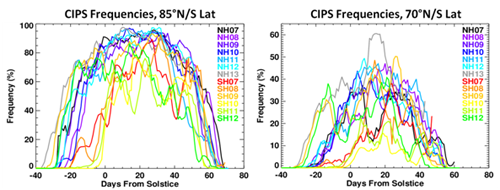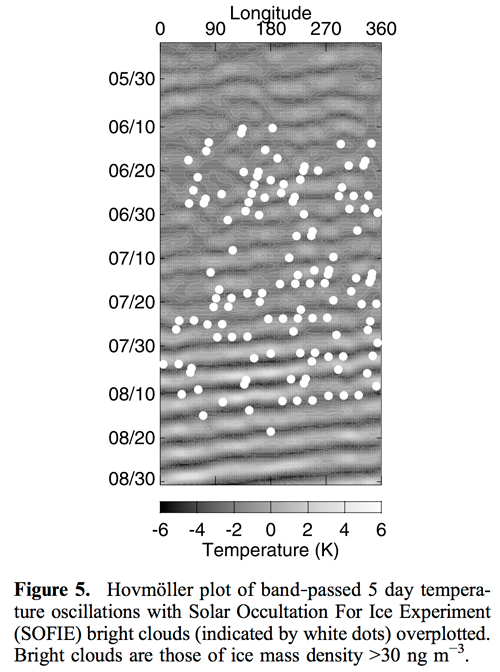|
STATUS:
10.29.2013
Spacecraft Status
The AIM spacecraft continues to perform well. All subsystems are operational. The flight operations team has been busy testing the communication between AIM and the newest member of the Tracking and Data Relay Satellites or TDRS. The team also is preparing to mitigate any impacts to the spacecraft due to the upcoming eclipse of the sun by the moon on November 3rd.
Instrument Status
CIPS: The CIPS instrument continues to perform well, with no health issues. Scattered light in the PX (forward) camera caused by the increasing beta angle continues to affect retrievals at solar zenith angles greater than about 92°. This affects only a very small fraction of the data, near the terminator on the ascending node. These points have been filtered out of the level 3 data products, but are still present in the level 2 data; users are cautioned not to use data at these high SZA values. Level 2 retrievals that will omit the high-SZA data from the PX camera are being developed. The figures here show the daily PMC frequencies derived from CIPS data for latitudes of 85° (left) and 70° (right) in both hemispheres. Overall variability is larger at 70° latitude, probably because of larger teleconnection effects. Analysis of season onset variability suggests that during the AIM time period, SH season onsets are controlled by teleconnections from the SH stratosphere as well as by the solar cycle, as seen previously in data from the Solar Backscatter UltraViolet instruments. Season onsets in the NH are likely also controlled by teleconnections from the SH stratosphere. Interestingly, interannual variations in NH season onset are in the opposite direction expected from direct effects of the solar cycle.

SOFIE: SOFIE continues to operate nominally as it completed observations of the 13th PMC season seen by AIM. The current PMC season began on May 13 and ended on August 31, 2013. This was the longest PMC season observed by AIM to date, at 109 days duration. The previous six Northern Hemisphere seasons ranged in duration from 94 to 103 days. The relatively early onset of PMCs this year has been tied to low temperatures and elevated water vapor, compared to previous seasons While the specific drivers behind these differences is not yet understood, one suspect is increased wave activity. A related study by Nielsen et al. [2010] demonstrated how waves affect the PMC season, using a combination of SOFIE observations and model analysis. The figure below (from Nielsen et al.) shows how SOFIE PMC detections are collocated with the cold troughs of the 5-day wave, in particular during the later part of the season. The effect of wave activity was demonstrated to extend the PMC season into times when the zonal mean temperature was above the frost point.

click to enlarge
|
